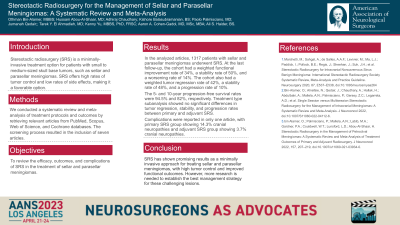Stereotactic Radiosurgery for the Management of Sellar and Parasellar Meningiomas: A Systematic Review and Meta-Analysis
Stereotactic Radiosurgery for the Management of Sellar and Parasellar Meningiomas: A Systematic Review and Meta-analysis
Friday, April 21, 2023


Hussam Abou-Al-Shaar, MD
Neurosurgery Resident
University of Pittsburgh Medical Center
Pittsburgh, Pennsylvania, United States
ePoster Presenter(s)
Introduction: Several studies have demonstrated the safety and efficacy of stereotactic radiosurgery (SRS) for skull base meningiomas. The present study aims to review the efficacy, outcomes, and complications of SRS in treating sellar and parasellar meningiomas.
Methods: Relevant articles were retrieved from PubMed, Scopus, Web of Science, and Cochrane. A systematic review and meta-analysis of treatment protocols and outcomes were conducted per PRISMA guidelines.
Results: Seven articles describing 1317 patients (median age: 54 years [range, 48.6-56.5 years]; females comprised 74%) who underwent SRS to manage their sellar and parasellar meningiomas were included. At the last follow-up, the cohort had a weighted functional improvement rate of 34% (95% CI: 31-37%), a stability rate of 50% (95% CI: 47-53%), and a worsening rate of 14% (95% CI: 12-17%). At the last follow-up, the cohort had a weighted tumor regression rate of 42% (95% CI: 39-45%), a stability rate of 48% (95% CI: 46-51%), and a progression rate of 10% (95% CI: 8-12%). The cohort’s weighted 5- and 10-year progression-free survival rates were 94.5% (95% CI: 93-96%) and 82% (95% CI: 79-84%), respectively. The treatment type subanalysis (primary SRS and adjuvant SRS) showed comparable weighted tumor regression rates (Primary SRS: 34% [95% CI: 12-66%] vs. adjuvant SRS: 27% [95% CI: 10-54%]; p=.69), stability rates (Primary SRS: 57% [95% CI: 21-87%] vs. adjuvant SRS: 60% [95% CI: 29-85%]; p=.89), and progression rate (Primary SRS: 9% [95% CI: 3-23%] vs. adjuvant SRS: 11% [95% CI: 6-21%]; p=.67). Only one article reported complications, showing 12 (14.3%) cranial neuropathies in the primary group and 2 (3.7%) cranial neuropathies in the adjuvant group.
Conclusion : SRS provided a minimally invasive approach with high tumor control and improved functional outcomes in patients with seller and parasellar meningiomas. Further studies are required to elucidate the optimum management paradigm in such a surgically challenging location.
Methods: Relevant articles were retrieved from PubMed, Scopus, Web of Science, and Cochrane. A systematic review and meta-analysis of treatment protocols and outcomes were conducted per PRISMA guidelines.
Results: Seven articles describing 1317 patients (median age: 54 years [range, 48.6-56.5 years]; females comprised 74%) who underwent SRS to manage their sellar and parasellar meningiomas were included. At the last follow-up, the cohort had a weighted functional improvement rate of 34% (95% CI: 31-37%), a stability rate of 50% (95% CI: 47-53%), and a worsening rate of 14% (95% CI: 12-17%). At the last follow-up, the cohort had a weighted tumor regression rate of 42% (95% CI: 39-45%), a stability rate of 48% (95% CI: 46-51%), and a progression rate of 10% (95% CI: 8-12%). The cohort’s weighted 5- and 10-year progression-free survival rates were 94.5% (95% CI: 93-96%) and 82% (95% CI: 79-84%), respectively. The treatment type subanalysis (primary SRS and adjuvant SRS) showed comparable weighted tumor regression rates (Primary SRS: 34% [95% CI: 12-66%] vs. adjuvant SRS: 27% [95% CI: 10-54%]; p=.69), stability rates (Primary SRS: 57% [95% CI: 21-87%] vs. adjuvant SRS: 60% [95% CI: 29-85%]; p=.89), and progression rate (Primary SRS: 9% [95% CI: 3-23%] vs. adjuvant SRS: 11% [95% CI: 6-21%]; p=.67). Only one article reported complications, showing 12 (14.3%) cranial neuropathies in the primary group and 2 (3.7%) cranial neuropathies in the adjuvant group.
Conclusion : SRS provided a minimally invasive approach with high tumor control and improved functional outcomes in patients with seller and parasellar meningiomas. Further studies are required to elucidate the optimum management paradigm in such a surgically challenging location.
